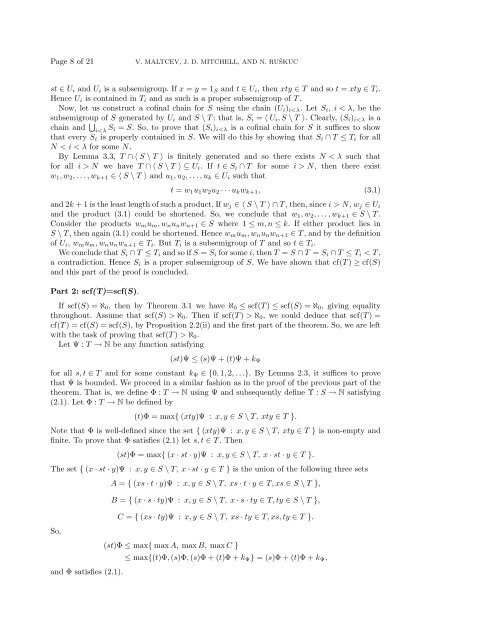The Bergman property for semigroups
The Bergman property for semigroups
The Bergman property for semigroups
Create successful ePaper yourself
Turn your PDF publications into a flip-book with our unique Google optimized e-Paper software.
Page 8 of 21<br />
V. MALTCEV, J. D. MITCHELL, AND N. RUŠKUC<br />
st ∈ U i and U i is a subsemigroup. If x = y = 1 S and t ∈ U i , then xty ∈ T and so t = xty ∈ T i .<br />
Hence U i is contained in T i and as such is a proper subsemigroup of T .<br />
Now, let us construct a cofinal chain <strong>for</strong> S using the chain (U i ) i ℵ 0 . <strong>The</strong>n if scf(T ) > ℵ 0 , we could deduce that scf(T ) =<br />
cf(T ) = cf(S) = scf(S), by Proposition 2.2(ii) and the first part of the theorem. So, we are left<br />
with the task of proving that scf(T ) > ℵ 0 .<br />
Let Ψ : T → N be any function satisfying<br />
(st)Ψ ≤ (s)Ψ + (t)Ψ + k Ψ<br />
<strong>for</strong> all s, t ∈ T and <strong>for</strong> some constant k Ψ ∈ {0, 1, 2, . . .}. By Lemma 2.3, it suffices to prove<br />
that Ψ is bounded. We proceed in a similar fashion as in the proof of the previous part of the<br />
theorem. That is, we define Φ : T → N using Ψ and subsequently define Υ : S → N satisfying<br />
(2.1). Let Φ : T → N be defined by<br />
(t)Φ = max{ (xty)Ψ : x, y ∈ S \ T, xty ∈ T }.<br />
Note that Φ is well-defined since the set { (xty)Ψ : x, y ∈ S \ T, xty ∈ T } is non-empty and<br />
finite. To prove that Φ satisfies (2.1) let s, t ∈ T . <strong>The</strong>n<br />
(st)Φ = max{ (x · st · y)Ψ : x, y ∈ S \ T, x · st · y ∈ T }.<br />
<strong>The</strong> set { (x · st · y)Ψ : x, y ∈ S \ T, x · st · y ∈ T } is the union of the following three sets<br />
So,<br />
and Φ satisfies (2.1).<br />
A = { (xs · t · y)Ψ : x, y ∈ S \ T, xs · t · y ∈ T, xs ∈ S \ T },<br />
B = { (x · s · ty)Ψ : x, y ∈ S \ T, x · s · ty ∈ T, ty ∈ S \ T },<br />
C = { (xs · ty)Ψ : x, y ∈ S \ T, xs · ty ∈ T, xs, ty ∈ T }.<br />
(st)Φ ≤ max{ max A, max B, max C }<br />
≤ max{(t)Φ, (s)Φ, (s)Φ + (t)Φ + k Ψ } = (s)Φ + (t)Φ + k Ψ ,
















